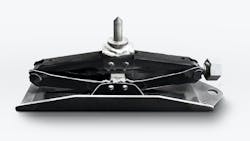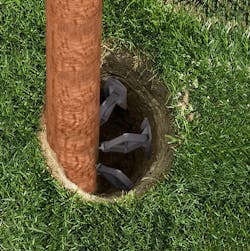At Salt River Project (SRP), the transmission group strives to work smarter, not harder. Lately, the team members have identified tasks in pole maintenance and construction with room for improvement.
After conducting research on these challenges, they discovered other utilities are facing similar issues. To tackle the obstacles head on, SRP began inventing specialized tools to help the line crews to improve productivity. By developing prototypes, the company aimed to make lineworkers’ jobs easier while increasing efficiency.
To ensure the designs were sound and to provide quality manufacturing, SRP partnered with an integrated product design and development firm. By bringing in outside help, SRP was able to bring its visions to life.
Providing Temporary Pole Support
SRP serves more than 1.1 million customers in central Arizona with an electric service area of 2,800 square miles. To cover such a large footprint efficiently, the line crews often try to prepare today for tomorrow’s workload. This helps the field workforce to better manage their work hours, adapt to changing conditions and address any challenges that arise during the project.
One of the ways SRP prepares for future needs is to do all the excavation work for pole change-outs on one day and then replace the pole and backfill the next. After digging out around a pole, a crew would typically lodge pieces of lumber into each hole to temporarily support the existing pole until it was replaced and backfilled. However, this method isn’t ideal. The poles would often lean a bit more than preferred, and removing the pieces of wood can be straining with tension on them.
Conducting Field Testing
SRP Transmission crews perform 200 pole change-outs annually, and the lineworkers can use the product to save time. Depending on conditions, the workers can use three or four jacks per pole, which provides better support than the crews’ previous approach of using lumber. Then, when they come back the next day, they can simply hold the pole while collapsing the jacks to remove them, rather than fighting to get pieces of wood out.
In addition to providing temporary support, the Pole Sitters offer benefits when setting new poles. When the base of a pole is placed in a hole, the jacks can be easily adjusted to make it plumb before filling the hole with rock or concrete. The fill material is poured around the jacks until the pole can stand freely, and then the jacks are collapsed and removed before completing the backfill.
The compact size of the Pole Sitters has also been beneficial from the standpoint of transporting them to the job site. Many of SRP’s jobs are remote access with supplies flown in by helicopter, so the lineworkers need to pack as compactly as possible. Because the Pole Sitters have a manageable size and weight, they are easy to handle and move to their intended location.
Inventing Specialized Supports
Another process that SRP wanted to improve was jacking together 230-kV steel pole sections with slip joint connections. The lineworkers construct these poles vertically, and their previous method was to use a crane to pull up a jack on one side of the pole and a handline to pull up the jack on the other side.
Instead, one self-contained piece of equipment could streamline the process and allow all the lifting to be done with the crane. The prototype included an engine and hydraulic pump for extending and retracting the hydraulic jacks. TTwo arms extended from the platform contained the engine and pump.
The arms made a “V” shape to hold a jack on each side of the steel pole. The complete assembly could be lifted with a crane, eliminating the need for a separate handline or to carry anything up in a bucket.
Having the engine and hydraulic pump positioned at the back of the tool helped balance out the weight of the jacks at the opposite end. It also eliminated the need to send up a hydraulic power unit with a bucket. This benefit keeps the workers in the bucket distanced from engine fumes, noise, potential hydraulic leaks and other undesirable consequences of working near the power unit.
After creating the prototype, SRP requested assistance with design and manufacturing. The engineers went to work and created the Slip Joint Pole Jack, which is now available to other utilities as well.
Saving Time
After receiving the completed product, SRP’s team put it to work on nine poles. Construction took the crew about 45 minutes per pole, compared to an hour to an hour-and-a-half. Time savings could be further increased on three- and four-section poles.
SRP is also adding a new feature to further improve the product. Initially, the hydraulic controls had to be operated at the pump, so the crew flew up a lineworker in a bucket to operate the jacks from the hydraulic power unit at the back of the tool. Now, the company is adding a controller with an extended cord, allowing the workers connecting the jacks to operate the unit.
Following the completion of the upgrade, SRP has another eight poles to set. Then, every fall or winter, SRP usually takes on a new 230-kV project, which could range from 10 to 80 poles each.
SRP is currently experiencing a lot of growth in its area, which means the crews are building a lot of 230-kV poles and have a lot of work ahead for the Slip Joint Pole Jack.
By using their field experience to help to launch the two new products, SRP Transmission crews have made their pole change-outs and construction jobs easier and more efficient. As a result, they can do more work in less time and work smarter, not harder on the job site.
JD Newham ([email protected]) is a transmission group supervisor for Salt River Project. He invented the two products and worked with LineWise to bring them to market.
About the Author
JD Newham
JD Newham ([email protected]) is a transmission group supervisor for Salt River Project. He invented the two products and worked with LineWise to bring them to market.

